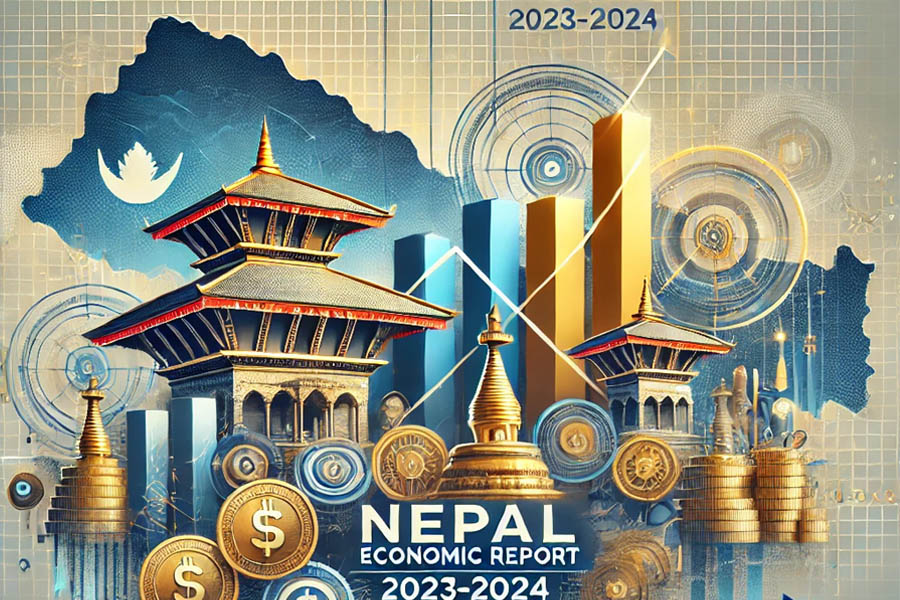Current Macroeconomic and Financial Situation of Nepal
December 22, 2024
As the year unfolded, Nepal's economy painted a picture of cautious optimism, not quite a vivid bloom, but rather a soft, muted hue — somewhere between the deep blush of a dark rose and the faint shimmer of a pale one. Consumer price inflation eased to 5.38%, a gentle decline from the 8.08% surge of the previous year, signaling a breath of relief amidst the storm. The ebb in prices, like a calming tide, was seen in the steady rhythms of Food and Beverages (6.01%) and Non-Food and Services (4.89%), where fluctuations whispered stories of both strain and growth. The Food sector saw spices soar with fiery passion (36.46%), sugar sweetened its rise (14.59%), and fruits blossomed with a 14.01% increase, yet the cooling winds of decrease brushed over ghee and oil (-14.23%) and vegetables (-5.35%).
In the broader Non-Food and Services realm, inflation painted strokes of vibrance in areas like Recreation and Culture (12.84%) and Education (8.92%), while the quieter, steadier pulse of transportation dipped by 1.86%. The trade winds, though fickle, carried mixed signals, with imports falling by 3.8% and exports slipping by 7.7%, yet the narrowing trade deficit — down by 3.3% — offered a glimpse of balanced resilience. The picture, though not entirely free of shadows, carries within it a flicker of hope, a reminder that even in the midst of complex shades, there remains the promise of steady growth, like a garden of tempered blooms.
Inflation
The year-on-year (y-o-y) consumer price inflation moderated to 5.38% in mid-November 2023 compared to 8.08% a year ago. Inflation in the Food and Beverage category stood at 6.01%, while inflation in the Non-Food and Services category was 4.89%.
Food and Beverage Category
- Spices: 36.46%
- Sugar & Sugar Products: 14.59%
- Fruit: 14.01%
- Cereal Grains & Products: 12.02%
- Milk Products & Eggs: 11.00%
- Ghee & Oil: -14.23% (decrease)
- Vegetables: -5.35% (decrease)
Non-Food and Services Category
- Recreation & Culture: 12.84%
- Miscellaneous Goods & Services: 10.76%
- Education: 8.92%
- Furnishing & Household Equipment: 5.27%
- Clothes & Footwear: 4.96%
- Transportation: -1.86% (decrease)
Trade Highlights
Imports decreased by 3.8%, exports fell by 7.7%, and the trade deficit narrowed by 3.3%.
The export composition was dominated by 55.6% intermediate goods and 44.1% final consumption goods. Capital goods accounted for a negligible 0.3% of total exports.
In imports, intermediate goods made up 49.2%, final consumption goods 42.1%, and capital goods 8.8%.
Remittances
Remittance inflows surged by 26.4% to NPR 477.96 billion, equivalent to a 23.1% increase in USD terms to USD 3.60 billion.
Net transfers increased by 24.9% to NPR 521.40 billion. The number of Nepali workers seeking foreign employment approvals also grew significantly.
Current Account and Balance of Payments
The current account registered a surplus of NPR 96.38 billion, compared to a deficit of NPR 37.79 billion in the previous year. In USD terms, the current account surplus was USD 725.1 million.
Balance of Payments (BOP) showed a surplus of NPR 147.11 billion (USD 1.11 billion).
Foreign Exchange Reserves
Gross foreign exchange reserves increased by 10.2% to NPR 1696.78 billion, equivalent to USD 12.75 billion. Of this, reserves held by Nepal Rastra Bank (NRB) grew by 10.8% to NPR 1490.83 billion.
Interest Rates
- The weighted average 91-days treasury bills rate: 4.39% (down from 10.88% a year ago).
- Inter-bank transaction rate: 3.47% (down from 8.50%).
- Commercial banks' average base rate: 9.74% (down from 10.60%).
- Weighted average lending rate of commercial banks: 11.96%.
Capital Market
The NEPSE index stood at 1852.09 in mid-November 2023, compared to 1911.26 in mid-November 2022.
Despite these challenges, the economy experienced positive developments. Remittance inflows surged by 26.4% to NPR 477.96 billion, supporting a current account surplus of NPR 96.38 billion, a significant turnaround from the previous year's deficit. Foreign exchange reserves increased by 10.2%, reaching NPR 1696.78 billion (USD 12.75 billion). Interest rates saw a significant decline, with the 91-day treasury bill rate dropping from 10.88% to 4.39%. However, the capital market, represented by the NEPSE index, saw a slight decline from 1911.26 to 1852.09, indicating a more subdued market sentiment. These positive shifts, alongside fiscal stability, position the country for potential growth as it navigates both inflationary pressures and global economic challenges.
Source: Based on Four Months Data Ending Mid-November, 2023/24 Published by Nepal Rastra Bank Economic Research Department, Baluwatar, Kathmandu
Stay Updated on Nepal's Economic Milestones
The trade winds, though fickle, carried mixed signals, with imports falling by 3.8% and exports slipping by 7.7%, yet the narrowing trade deficit — down by 3.3% — offered a glimpse of balanced resilience in FY 2023/24.
Subscribe for Economic Insights
Stay ahead with expert analysis and exclusive updates on Nepal's evolving economy.
Read More From Us
- 🌟🌟🌟🌟🌟 For more International Breaking News visit us at International News
- 🌟🌟🌟🌟 For More Russia-Ukraine War updates, click here
- 🌟🌟🌟🌟🌟 For more International Trade Business news, hit here
Tags: #NepalEconomy #FiscalYear2023 #NepalEconomicReport #Macroeconomy #InflationTrends #TradeDeficit #RemittanceGrowth #ForeignExchange #NEPSE #EconomicInsights #GlobalPostHeadline
Thank you for reading: globalpostheadline.com






